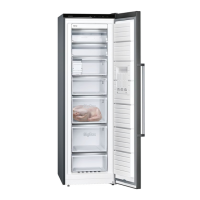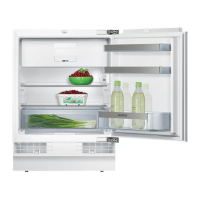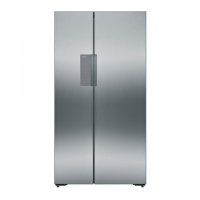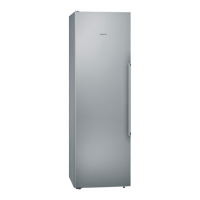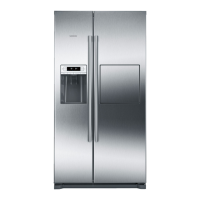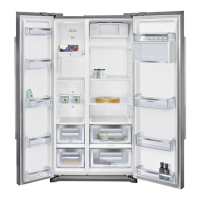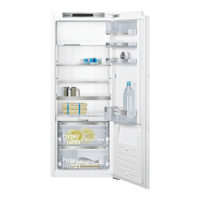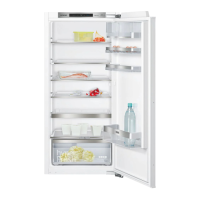
Do you have a question about the Siemens GS Series and is the answer not in the manual?
| Brand | Siemens |
|---|---|
| Model | GS Series |
| Category | Refrigerator |
| Language | English |
Crucial step to read instructions for safe installation, use, and maintenance of the appliance.
Focuses on refrigerant safety, power cord integrity, and ensures repairs are done by qualified personnel.
Guidelines on electrical appliances, steam cleaning, sharp implements, and flammable substances for safe operation.
Safety advice for children, including handling packaging and supervision to prevent suffocation.
Information on appliance suitability for freezing/ice making and intended home environment use.
Environmentally friendly disposal of packaging materials and advice on local options.
Recycling old appliances according to WEEE directive and professional disposal of refrigerant.
List of items included in the delivery, such as appliance, fittings, manuals, and warranty information.
Recommended ambient temperatures for different climate classes (SN, N, ST, T) for optimal operation.
Importance of unobstructed ventilation openings for efficient operation and to prevent increased power consumption.
Professional installation, water connection requirements, and initial setup steps.
Socket proximity, accessibility, voltage, and fuse requirements for safe appliance connection.
Warnings against energy saver plugs and guidance on proper inverter use for appliance operation.
Identification and function of appliance controls: On/Off, Super, Temperature, Alarm buttons.
Procedure for powering on the appliance and initial warning signal handling.
Advice on initial cooling, NoFrost system, housing warmth, and safe door opening procedures.
How to adjust the freezer compartment temperature using the specific temperature setting button.
Explanation of door alarm (continuous sound) and thaw alarm signals and their respective causes.
Conditions triggering the temperature alarm and potential false alarms, e.g., during switch-on.
Details on power failure alarm, switching off alarms, and the function of the AquaStop system.
Information on usable capacity found on the rating plate and tips for fully utilising freezer volume.
Guidelines for buying frozen food, checking packaging, and placing it correctly in the freezer.
Advice on freezing fresh food, including blanching vegetables and listing suitable/unsuitable foods.
Proper methods and materials for packing food to prevent flavour loss, drying, and maintain airtightness.
Recommended storage durations for various food types at a temperature of -18°C.
How to activate manual or automatic super freezing for rapid and efficient food freezing.
Procedure for deactivating super freezing mode and returning the appliance to normal operation.
Recommended methods for thawing frozen food safely, including options for room temp, fridge, oven, or microwave.
Information on dispensing crushed ice and ice cubes, and initial setup requirements for the ice maker.
Step-by-step guide to dispensing ice cubes or crushed ice, including selecting type and volume.
Procedure for temporarily disconnecting the ice maker to prevent ice cube freezing during prolonged non-use.
Steps to disconnect and reconnect the ice maker, including ice cube container handling and water supply.
Procedure for turning off the appliance and disconnecting it from the power supply.
Detailed steps for disconnecting the appliance for extended periods, including water supply and ice maker.
Warnings against abrasive cleaners, solvents, and dishwashers; advice on cleaning metallic surfaces.
Step-by-step guide for cleaning the appliance interior, seals, and drainage channels with suitable materials.
Instructions for removing and cleaning interior parts, including the ice cube container, to maintain hygiene.
Information about the maintenance-free LED light and details on who can perform repairs.
Advice on installation, ventilation, food placement, door closure, and wall spacers for energy efficiency.
Explanation of normal operational sounds and tips to prevent unwanted appliance noises.
Table of common faults, possible causes, and remedial actions for self-repair to avoid unnecessary service calls.
Resolving issues with warning signals, temperature not reached, or showroom mode activation.
Troubleshooting common problems with the ice maker and dispenser not working or producing deformed ice.
Steps to initiate and interpret the automatic self-test program for diagnosing potential faults.
Details on warranty coverage for water damage caused by a defective Aqua-Stop system, including installation prerequisites.
Information on how to contact customer service, providing essential product numbers for faster assistance.
